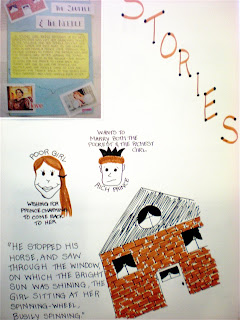An artifact can be anything that has meaning to you. Something that was given to you, something that you earned, or something that represents you. The artifacts that are important to you help to illustrate who you are. Some of my artifacts include my travel pillow that has been with me almost every time I travel, both in the United States and the few times I've gone overseas, my Israel scrapbook which documents the two months I spent studying abroad in Israel, and hearts from when a group of my close friends "heart-attacked" my room for my 18th birthday.



STORIES
Everyone has his or her own story that tells who that person is. After reading the children's fairytale "The Spindle, The Shuttle, and The Needle," I am able to see how the simple details and morals of the story relate to real life. In the story, for example, a poor girl in a small village ends up marrying a prince and they live happily ever after. The story portrays the idea that everyone should have faith and hope and that good things can happen to anyone.
Even though she thought she was worth nothing, the prince "stopped his horse, and saw through the window, on which the bright sun was shining, the girl sitting at her spinning-wheel, busily spinning" -Grimms Fairy Tales. As the prince searched for both the poorest girl and the richest girl in countless villages, he finds that this poor girl, busily working trying to earn money, is also the richest girl.

TRANSLATION
Being able to translate our ideas and concepts into a reality is one of the most important things we can learn to do well. In our current studio project, I found the word translation to be a good word to describe what we are doing. After creating numerous sketches of ideas and details of our chair/table/workstation/storage project, we have to translate our two-dimensional objects into three-dimensional objects which requires a great deal of translation of measurements and imagination.
"The columns of the Propylaia are splendid examples of one of the three column types the Greeks evolved for their civic and religious architecture" (Roth, 30) This is a good example of how culture from different time periods is translated into a work of architecture.

 MULTIVIEW
MULTIVIEWThere are many different ways to look at objects or concepts. Every time you look at something in a different way, you can put things in a different perspective and can draw different conclusions from them. Every side of a building offers something different to consider. This past weekend, I was in Utah visiting my sister and I was amazed by all the mountains surrounding me. Any way you view them they are beautiful and there is always something to see.
 CYCLE
CYCLEA cycle is something that continues to grow and evolve. It is something that shows how a certain combination of events yields a set of results over and over again. The design cycle, for example, shows a continuance of cultural growth. In our History of Design (IAR 221) class, an example of a cycle was given: A chair is constructed and valued for its intricate design and beauty and is thus sold for a great deal of money. It stays in someone's house for a few years, and then is maybe passed down to a daughter or son who then gives it to their child after a few years as 'cheap furniture' to use as they move into an apartment. When they move out of the apartment, they sell the chair to a pawn shop or leave it out for the trash until someone sees it and puts it into an antique museum. This cycle shows how something has great value, then is considered old and not valuable, and then how it ends up back in a high-value setting.
SYNOPSIS
All five words for this week's Opus, Artifacts, Stories, Translation, Multiview, and Cycle, are all inter-related. All of these concepts relate to the idea that we carry the past with us and build upon it to help create and influence our future. Without the artifacts, we would have nothing to remember our past, stories can only continue if they have a solid past to build upon, and translation helps us to interpret our past and see how we can improve our actions for the future. Multiview allows us to see our past, present, and future in different perspectives that we can learn from, and the cycle is the series of events and results that continue to form as we continue on from the past to the future.